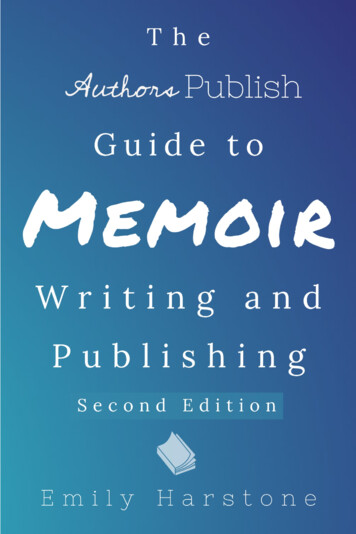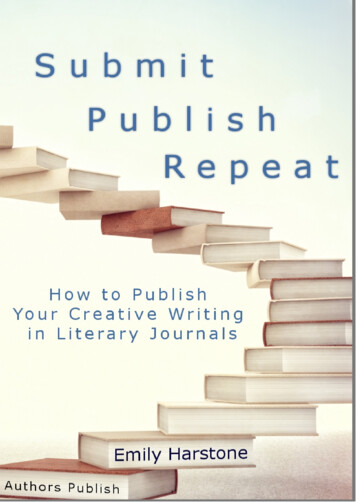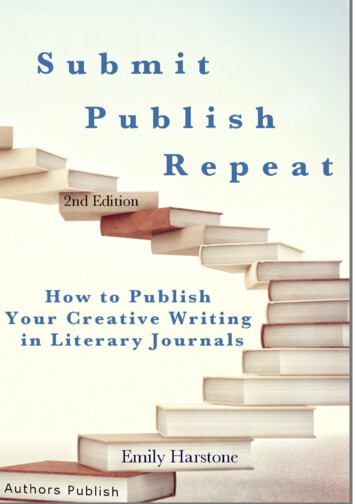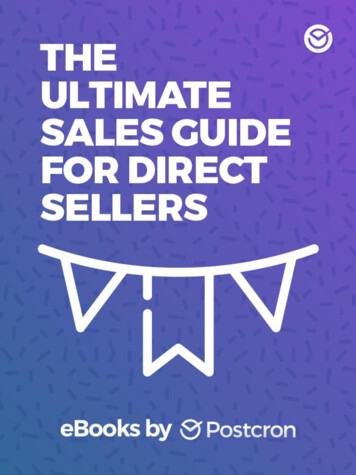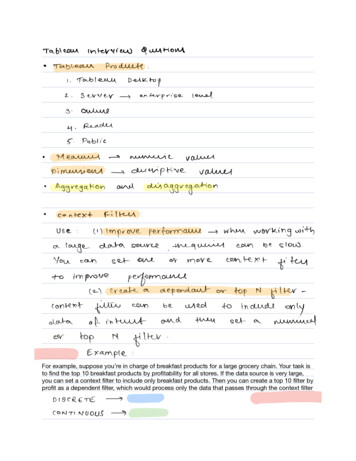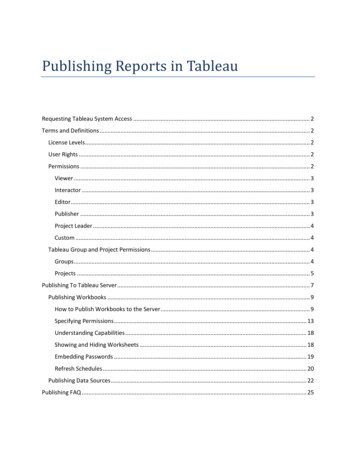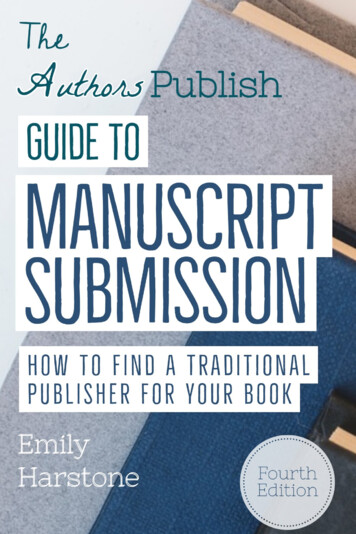
Transcription
TheAuthors PublishGuide toManuscriptSubmissionFourth EditionEmily Harstone
Copyright 2020 Authors Publish. Do not distribute without explicitpermission.To share this book with a friend, please send them /Corrections, complaints, compliments, criticisms? Contactsupport@authorspublish.com
More Books from Emily HarstoneSubmit, Publish, Repeat:How to Publish Your Creative Writing in Literary JournalsThe Authors Publish Guide to Memoir Writing and PublishingThe Authors Publish Compendium of Writing PromptsThe Authors Publish Guide to Children’s and Young AdultPublishingMore Books from Authors PublishHow to Promote Your BookThe Six Month Novel Writing Plan8 Ways Through Publishers BlockThe Authors Publish Quick-Start Guide to Flash FictionCourses & Workshops from Authors PublishWorkshop: Manuscript Publishing for NovelistsWorkshop: Submit, Publish, RepeatThe Novel Writing Workshop With Emily HarstoneThe Flash Fiction Workshop With Ella Peary
Table of ContentsIntroduction . 8Chapter 1: Manuscript Preparation . 11Chapter 2: An Overview of the Submission Process . 16Chapter 3: How to Write a Query Letter . 22Chapter 4: How to Write a Good Pitch . 28Chapter 5: An Overview for Fiction Writers . 32Chapter 6: An Overview for Nonfiction Writers . 35Chapter 7: Building an Author Platform . 41Chapter 8: How to Write a Synopsis . 48Chapter 9: How to Get an Agent . 52Chapter 10: How to Research an Agent . 56Chapter 11: The Seven Most Common Manuscript SubmissionMistakes. 64Chapter 12: Agent versus Publisher . 72Chapter 13: How to Evaluate a Publisher for Your Book . 77Chapter 14: Alternative Ways to Connect with Agents andPublishers . 82
Chapter 15: The Self-Publishing Conundrum and the Importanceof Patience . 89Chapter 16: The Top 38 Publishers for New Authors . 94Glossary . 110Acknowledgments . 115About the Author . 116
IntroductionOften, writers will finish their first manuscript, and only after it iscomplete, they will wonder: Where do I go from here? This bookanswers that question. It walks readers through the process ofturning a manuscript into a book.The ideal reader of The Authors Publish Guide to ManuscriptSubmission will have already completed writing their manuscriptor be close to finishing the first draft.It would also be helpful to someone who has finished multiplerevisions and is struggling to find an agent or a publisher.The majority of this book focuses on the submission process, fromquery letters to agents and publishers who accept directsubmissions. This book should answer all of the questions youhave about manuscript submission, as well as some of thequestions you didn’t know you had.The focus of this book is primarily on fiction manuscripts, but wehave added more information focusing on nonfiction submissions,which are very different.Emily Harstone8
We cover issues that trip up a lot of new authors, including selfpublishing, vanity publishers, copyright, and the importance ofpatience, as well as some of the different issues facing nonfictionauthors.For a long time, submitting seemed strange and mysterious to me.It seemed too overwhelming to actually do. In fact, for the mostpart, submitting is relatively easy. This book will help demystifythe process for you.This is the fourth edition of The Authors Publish Guide toManuscript Submissions. Some of the sections of the book havebeen updated to reflect changes in the publishing world and othershave been altered to explore certain aspects of the process in moredepth.The bulk of the new information this book contains is about thequerying process, as well as adding additional resources in termsof agents, publishers, and beta readers.Over 5,000 words of content have been added to this book to makeit better and more thorough. Some of the additions came based onthe generous feedback we received about the first and secondedition of the book.We cover a few of those publishers in this book, but to get the bulkof the reviews, you would have to read The 2020 Guide toEmily Harstone9
Manuscript Publishers. You can also search our manuscriptpublisher reviews online here.I also teach a course that focuses exclusively on manuscriptpublishing for novelists. If you are interested, you can add youremail address to the waitlist here.The course covers much of what the book covers, but providesadditional information in terms of revisions, querying, agents, andpublishers. I also offer detailed feedback on the first twenty pages,query letters, synopsis, and potential agents and publishers.Still, you should be able to learn everything that you need to knowin order to submit well from this book. A number of our readershave successfully placed manuscripts by following the adviceoutlined here.I wish all of my readers the best of luck.Emily Harstone10
Chapter 1:Manuscript PreparationThis chapter is an overview. Deep revisions take time, effort, andpersistence. Different manuscripts require different amounts ofrevision. But if you follow the steps below, you will end up facingthe right direction.When you write a book, it is officially called a manuscript until itis published. One of the tricky things about writing is that it can bevery hard to discern when a manuscript is actually finished andready to be submitted to an agent. This, too, is the case if yourbook is self-published.Some authors constantly tweak their work. Others finish one draftand declare it finished, which is usually not the best course ofaction, unless you want to self-publish.I follow three steps to know that my manuscript is done.Sometimes I repeat these steps, even after I start submitting.Once I finish my first draft, and before I let anyone else see it, Iedit it twice. The first draft of editing is just for spelling andEmily Harstone11
grammatical errors. I often mess up my tense shifts, so I try to keepan eye on that. Everyone has different areas where they are morelikely to make errors, so it is good to know your trouble spots andfocus on them when editing.During the second round of editing, I am more focused on thecontent. I think of this as the revisions stage. During this stage Iwant to make sure that the characters come across as authentic. Iwant to make sure the plot is interesting and doesn’t have anygaping holes. I do not change anything significant at this point interms of plot or character development, because I want feedbackfirst. This is supposed to be the editing stage, and not the revisingstage.Only once I’ve done at least one round of editing and revisions amI ready to pursue the second step.The second step is to find and organize a small group of readers.Try and choose at least five people whose opinions you trust andgive them a copy of your manuscript. Do not expect feedback fromall five, but handing out your manuscript to so many people willguarantee that you get at least some feedback.These five people can be friends, but it’s better if they are not. It’sgreat to find either experienced beta readers or other writers toexchange your work with.Emily Harstone12
Beta readers can be found online. There are a number of BetaReading communities on Facebook including the large and activegroup, Beta Readers & Critiques. There are other active beta readergroups on FB, many structured around genre, so take a look aroundbefore deciding what groups the best fit for you.On Goodreads there’s also an active beta reader community calledBeta Reader Group.Beta readers aren’t editors, they’re first readers and they tend tofocus on story and character. A good beta reader gives you honestfeedback and helps improve your overarching story. They aren’tthere to fix all your typos.If you want any feedback on specific elements of the manuscript,type up a list of questions for the reader to keep in mind. This willhelp them focus on giving you the feedback that you need.Make sure that when they give you feedback you appreciate thecompliments as well as take in the criticism. Read over all thefeedback carefully and then let it set for a little bit. Don’t doanything drastic to your book for at least two weeks.The third step is editing and perhaps even revising the book; this isbased on the feedback which you received. You don’t have to takeevery nitpicky suggestion your readers made, but make sure toaddress any of the legitimate concerns they may have had. At thisEmily Harstone13
point in the process, I hire a professional editor to review all of mywork for errors and to provide feedback on general plot points. Ifyou cannot afford to hire an editor, it is fine to proceed withoutone.After this draft and one final review for any minor errors, yourmanuscript should be ready to submit. However, if you have anidea for a change in your plot or other revisions, and you havereceived a number of rejections, feel encouraged to revise yourbook again.Don’t let the fact that your manuscript is probably not 100 percenterror free prevent you from submitting it. I often spot errors in NewYork Times best-sellers. It is nearly impossible to be error-free,even with a professional editor. The hope with editing andrevisions is to get your work to the point where errors don’tdistract from the plot and the plot is clear and easy to follow.If you are struggling to get a book published and have submitted itto twenty or so publishers without any response, except for cannedrejections (personal rejections are often a compliment and shouldbe seen as such), you should consider another major round ofrevisions.If you are mostly querying with the first two to three chapters, Isuggest that you focus the revisions there. Most authors use thosechapters as the “on ramp”; when they are first writing the book,Emily Harstone14
they are orientating themselves to the world and the characters theyare creating. It is their entry way into the world of the book, but itis not always helpful for, or even geared toward, readers.I have re-written the first three chapters of the last two novels Ihave written, always with positive results. Both times I changedsomething major that meant I had to make minor edits throughoutthe rest of the book for consistency. In one of them, the event thatbecame the first chapter had initially occurred before the bookitself started, but it made so much more sense for readers to seethat event as the first chapter, because it had lasting results, and itmade that character a lot more relatable from the start, which madethe book as a whole more appealing.Don’t be scared to make major revisions. You can always save oldversions of your manuscript so you can switch back if you changeyour mind, or make an edit that doesn’t work. Just be sure to titlethe document something that makes it clear what version of thestory it is.Emily Harstone15
Chapter 2:An Overview of the SubmissionProcessMost publishers and agents want the same two things—a queryletter and a synopsis. They also expect an excerpt of your book,generally the first two chapters, although there is a lot of variationin terms of length. If it is a picture book, they generally want thewhole manuscript. Also, some publishers want the wholemanuscript regardless of length. If it is nonfiction you aresubmitting, your manuscript does not even need to be completeand your proposal could just involve one sample chapter and anoutline.There are specific requirements that differ from publisher topublisher and from agency to agency, and also from genre togenre; however, it is good to have a basic query letter and synopsisthat you modify to meet the needs of the given agent or publisher.Just make sure you send the correct version to the right person. ItEmily Harstone16
really annoys a publisher to receive submissions with anotherpublisher’s name on it. The same goes for agents.Make sure your sample chapters are perfectly polished andformatted. Some publishers want the full manuscript submittedfrom the start, but all of them expect to receive the full manuscriptif they request to see it, so it is particularly important to do theformatting correctly. This article covers correct formatting (and theways it is changing) in detail.You should spend a lot of time and consideration crafting the coveror query letter. This is the first impression you will make on agentsand publishers. The next chapter focuses on how to compose agood query letter and the chapter following it will focus on how tocraft a good synopsis.It is important to note that many publishers expect informationabout your author platform or marketing plan either as a separateentry, or as part of your query letter. Don’t know where to start interms of an author platform? Chapter 6 will cover that informationin depth.If you meet a publisher or an agent directly at a conference, mostwant a pitch. A pitch can also be handy to include in your coverletter. Don’t know what a pitch is? Chapter 4 talks about what apitch is, and more importantly, how to make a good one. I alwaysinclude my pitch in my cover letter.Emily Harstone17
Not all publishers and agents require a synopsis, but many do.Most want a complete synopsis of the plot that fits on one page. Bycomplete synopsis, I mean they want spoilers. They also generallywant information about character development. Chapter 8 willfocus on how to craft a good synopsis.It should go without saying, but it is very important to edit andpolish the query letter and synopsis. If you can afford an editor, getthem to review the query letter, the synopsis, and also the firsttwenty pages. Twice. Or more. The first twenty pages of the novelare all that most agents and many publishers will initially see, somake sure they are compelling and error-free.If you are focusing on finding an agent, then you should read thisarticle: The Safest Way to Search For an Agent. One of the best,reputable search engines for agents is Query Tracker. You can startlooking for an agent there, but not all agents on that site are goodagents. This is why additional research is often needed, but thedetails of what that research involves are covered in Chapter 10;Chapter 9 focuses on a basic overview of submitting to agents.Chapter 11 takes into account information from authors, agents,and publishers about common submission mistakes that lead torejection. It is a must-read before you begin the submissionprocess.Emily Harstone18
Once you have completed a query letter and a synopsis that you arehappy with, start to research where you are going to submit yourbook. You can start your research earlier, if you wish.You should decide early on if you want to submit directly topublishers or if you want to submit to an agent. Chapter 12 coversthe various pros and cons of both options.If you are looking at submitting a manuscript directly to apublisher, our index of manuscript publishers is a good place tostart. We always check watchdog sites before reviewing apublisher, but it is also good to verify the information yourself.Remember, there is no such thing as a legitimate traditionalpublisher that charges its writers. You should be paid by yourpublisher, not the other way around. The term hybrid publishing isoften used as an excuse to charge writers. It is not the same astraditional publishing.The only time a traditional publisher can potentially ask formoney, and remain a traditional publisher, is in terms of readingfees. Most poetry presses charge these, and more independentpresses, including ones I admire, like Two Dollar Radio are nowcharging to read submissions.When examining a publisher’s website, this article will help youknow what to keep an eye out for.Emily Harstone19
Some publishers can respond to submissions within weeks, whileothers will respond within years, so, keep that in mind. If you havenot heard from a publisher in six months, you should email them toask about the status of the manuscript, unless they explicitly saythey will take longer on their website.Many publishers explicitly state on their site that they won’trespond to manuscripts they aren’t interested in, and if you haven’theard from them within a stated period of time, one should assumerejection. There is nothing wrong with this policy, in my opinion.It can seem frustrating, but it allows more publishers to remainopen to direct submissions.Once you find agents or publishers that you feel would be a goodfit, you should check and double-check their submissionguidelines.Most publishers accept electronic submissions through email or asubmission manager, but a few still require submissions throughthe post. Either way, the publisher’s submission guidelines shouldwalk you through the steps. The same goes for agents.It is important not to submit to an agent or publisher if they saythey are closed to unsolicited submissions. Your manuscript willnot be read and in all likelihood, you will annoy the person orpersons who receive it. This could hurt your chances in the future.Emily Harstone20
It’s even more important to submit to publishers and agents thatare open to publishing or representing the genre you are writing in.A lot of authors mass submit to agents and publishers ignoringtheir individual guidelines, and the authors work ends up wasting alot of individuals time. Other times authors submit to publishersthat don’t accept the genre the author is writing in, in the hopesthat the publisher will make an exception.This does not end in publication and often causes publishers to nolonger be open to direct submissions.During the submission process always make sure to track who youhave submitted your manuscript to, so that you don’t submit to thesame place twice.Emily Harstone21
Chapter 3:How to Write a Query LetterA query letter (sometimes referred to as a cover letter) is a singlepage letter introducing your book to an editor or a publisher thataccepts unsolicited submissions.When you write a query letter, always remember that it is similarto a cover letter in a job application. Be professional. Write in aformal style, even if that style is at odds with your novel. Makesure you repeatedly edit it for errors. Make sure it is typed and thefont is easy to read. A standard font like Times New Roman worksbest.Even though it is formal, try to engage with the reader. Try tofocus on what makes your book interesting and what sets it apartfrom other books.I receive a lot of query letters for fiction manuscripts at AuthorsPublish (even though we don’t publish fiction) and a lot of themare riddled with errors and focus on a personal story involvingfinancial obstacles. Publishers and agents don’t want to struggleEmily Harstone22
through reading an error-filled manuscript, and hearing aboutpersonal obstacles you face is not going to change their opinionabout publishing your manuscript, unless it’s a memoir or an#ownvoices work (manuscripts that depict marginalized or underrepresented group written by a person from that group).Keep it short and sweet; don’t use language that is too flowery.The query letter should consist of at least three main paragraphs:the hook, the summary, and the author’s bio. These should bepresented in letter format.You should lead with a sentence introducing the title, genre, andlength of your manuscript. This can segue into the hook but itdoesn’t have to.If you particularly like an author the agent you’re queryingrepresents, or a book the publisher published, then it is appropriateto mention that in your letter.I try to do a lot of research and personalize each letter at least alittle. Most agents and publishers are used to receiving mass emailsthat might not even reflect the genres they publish, so making itclear that you have done your research puts your query letter aheadof the others.Creating a Hook/PitchEmily Harstone23
The hook or a pitch is a one-sentence description of the book. Itshould be intelligent, intriguing, and concise.Your hook should not be a rhetorical question.An agent I knew handed me a small pile of query letters fromauthors that she rejected. Most of the letters she had not evenbothered finishing to read. She asked me what they all had incommon. By the third letter, it was clear they all started withrhetorical questions.In one query letter, every paragraph was composed entirely ofrhetorical questions.It is best to focus on your hook, be it your main character, thelocation, or something else entirely. That is the best way to keepthe sentence concise and maintain the agent’s interest.Also, make sure that the premise of your book soundsunique. Agents and publishers are unlikely to follow up with anauthor whose book appears to be generic. Including specifics helpsmake your manuscript stand out.I go into more details about how to write a pitch in the nextchapter. Wendy S. Delmater also offers great insight on how towrite a hook, which you can read here.Writing a Summary that Appeals to Agents and PublishersEmily Harstone24
The summary is the second paragraph, and should not be confusedwith the synopsis, which is separate from the cover letter.It is difficult to describe a novel in a paragraph or two. The key isto just focus on giving the agent an impression of what your novelis like, without getting bogged down by all the details.You don’t need to disclose the whole plot here, and it’s perfectlyfine to set up mysteries or actions within a summary, and notdisclose the resolution.Comparative TitlesGenerally, between the summary and the biography an authorshould include two to three comparative titles. Comparative titlesare the names of published books that have a lot in common withyours. Ideally these books would have been published in the lasttwo years. When mentioning the titles, talk about what your workhas in common with these titles, and also about what makes itdifferent.If there’s one title that your work has a lot in common with thatwasn’t published in the last five years, consider integrating it intothe hook, rather than including it as a comparative title. The samegoes for non-book comparisons. If you are going to drag movies orTV into it, think about how you can make that part of the hook.Emily Harstone25
Writing an Appealing Author’s BiographyThe author’s bio is not a necessary part of the query letter. If youhave not been published before, or do not hold a degree in creativewriting, it is probably best not to include an author’s bio at all—unless your profession influences the subject of your books. Forexample, Kathy Reich is a forensic scientist who writes novelsabout a forensic scientist who writes novels.ConclusionIn the conclusion to your letter, you should do two things:The first is to thank the agent or the editor for their time andconsideration. The second is to inform the agent that the full novelis available upon request.Do not include the entire manuscript with the letter. Most agentsrequest the first two or three chapters of your manuscript. Whensubmitting nonfiction, you should include an outline, table ofcontents, and a few chapters for their consideration.Once you have written your query letter, edit it repeatedly. Keeprefining it, even after you have started to submit it to agents. Evenmore tips, in terms of query letters, are included in Chapter 9, so IEmily Harstone26
encourage you to read that chapter as well before completing yourquery letter.It's helpful to see sample query letters as well, although I cautionagainst following their format too closely, which leads to aformulaic sounding query letter.This is a great sample query letter and feedback from the helpfulquery shark.Also, you can see Ann Leckie's query letter for her NYTbestselling novel Ancillary Justice here.In addition Jane Friedman's complete guide to query letters is veryhelpful and her blog is a great resource with a lot of additionalinformation.Emily Harstone27
Chapter 4:How to Write a Good PitchA pitch (also known as a hook) was such a foreign term for me as ayoung author, that when the first agent asked for my novel’s pitchat a conference, I blinked and shrugged. I was seventeen at thetime, so I suppose my reaction was understandable.The agent then had to explain to me what a pitch was. How it is anattempt to make the main concept of your novel understandableand appealing in the space of one or two sentences.I learned later that they could be longer than that, but the bestpitches are simple. They are not just two long sentences with lotsof complicated ideas. Ideally, they are simple, concise, andintriguing.For example, the pitch for the movie The Matrix could be any ofthe following sentences:Emily Harstone28
If Neo swallows the Red Pill the fate of his captured world will bein his hands.The whole world is captured, but intrepid rebels are trying to freeit.What you see is not real.Just kiss Trinity.Now some of those pitches are clearly better than others, somewould only work if you had seen the movie, some might intrigueyou enough to see the movie.My first attempt at a pitch was a complete failure, but I have sincesuccessfully pitched an agent a novel, through the followingmethods.Write a Lot of PitchesThis seems obvious, but it isn’t necessarily. You should startwriting pitches as often as possible if you are interested infollowing the path of publishing that involves agents. Eventraditional publishers often require pitches, so if you are submittingto publishers directly, it’s not a bad thing to practice.Emily Harstone29
When you watch a movie, write a couple of pitches for itafterward. Also sit down with your own novel and just writepitches for fifteen minutes. Don’t look at these pitches right away.Give it a few days, then review them. Once you have done this afew times, you should have three or four pitches that you like.Play with LengthTry writing longer pitches occasionally and then think of ways thatyou can trim them down to size.Play with FocusA novel has a lot of different things going on at the same time.There can be many themes and plots. Don’t try to cover all of it inthe pitch. Instead, try focusing on just one theme, plot, orcharacter.CompareThis sounds like a cheap trick but almost every agent I have evermet wants to compare your book to already successful books. Forexample, 50 Shades of Grey is the erotic version of Twilight, butwithout vampires. Agents want to know what your book is like, sosaying something like “The Matrix with aliens, not robots” mightintrigue someone.Emily Harstone30
Get FeedbackTake the pitches you really like and then show them to people—friends and family members that you trust. Some should have readthe novel already, others should not have. Their feedback will bevaluable as you develop your ability to write a good pitch.Emily Harstone31
Chapter 5: An Overview forFiction WritersMost adult fiction follows certain unstated and stated rules. Theserules cover everything from the length of a manuscript based on itsgenre, to what tense it’s written in.As a reader, I long assumed most of these rules are obvious. Butfrom reading so many unpublished manuscripts over the last fewyears, I have discovered that this is not the case.This chapter won’t be able to cover everything, but I am going totry to at least mention all of the most important points.The first thing I am going to cover is word counts. Most generalfiction is between 75,00 and 100,000 words in length. Generalfiction refers to popular fiction, the kind of books you often find atairport stores, on display near the entrance to Barnes & Noble.Books like The Rosie Project by Graeme Simsion and Where theCrawdads Sing by Delia Owens. Historical fiction, like The ParisWife by Paula McLain, lean toward being longer and are usuallybetween 80,000 and 120,000 words. Literary fiction is generallyEmily Harstone32
between 40,000 and 120,000 words in length and includes worklike The Dept. of Speculation by Jenny Offill and Transit byRachel Cusk.The list goes on. Mystery books tend to be between 75,000 and90,000 words. Thrillers start at the 80,000-word mark and can goup to 100,000 words. Fantasy and Science Fiction books tend to bebetween 90,000 and 125,000 words. Romance novels start ataround 50,000 words and go to 90,000 words, but they tend to beon the lower end of that range.Chapter books (pre-middle grade fiction), are between 5,000 and20,000 words in length. Middle grade fiction is between 30,00060,000 words. Books in the young adult genre are usually between60,000 and 80,000 words in length.There is sometimes a little leeway on either ends of theseguidelines, but it is best for first-time authors to be within theseguidelines. Once an author has a proven track record, it is easier tobecome an exception to these rules.Most published novels are written in past tense, not present tense.Past tense is much easier to read as a general rule because it’s lessnoticeable and more flexible. For the most part, present tense isonly used in experimental literary fiction or a novel that contains aduel timeframe.Emil
Submit, Publish, Repeat: How to Publish Your Creative Writing in Literary Journals The Authors Publish Guide to Memoir Writing and Publishing The Authors Publish Compendium of Writing Prompts The Authors Publish Guide to Children’s and Young Adult Publishing More Books from Authors Publish

